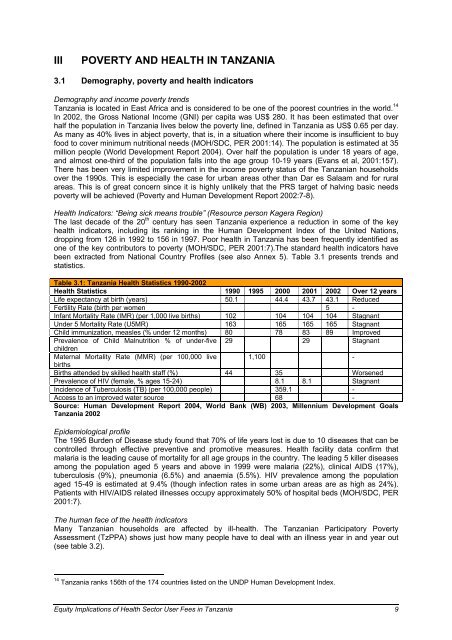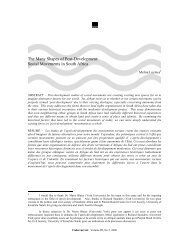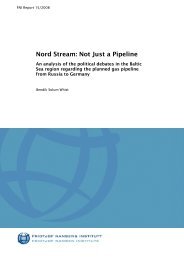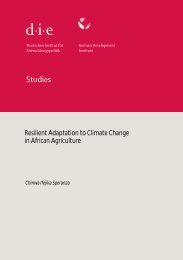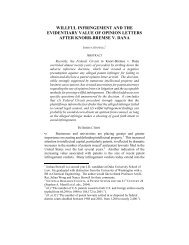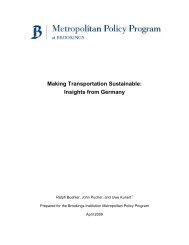equity implications of health sector user fees in tanzania
equity implications of health sector user fees in tanzania
equity implications of health sector user fees in tanzania
Create successful ePaper yourself
Turn your PDF publications into a flip-book with our unique Google optimized e-Paper software.
III POVERTY AND HEALTH IN TANZANIA<br />
3.1 Demography, poverty and <strong>health</strong> <strong>in</strong>dicators<br />
Demography and <strong>in</strong>come poverty trends<br />
Tanzania is located <strong>in</strong> East Africa and is considered to be one <strong>of</strong> the poorest countries <strong>in</strong> the world. 14<br />
In 2002, the Gross National Income (GNI) per capita was US$ 280. It has been estimated that over<br />
half the population <strong>in</strong> Tanzania lives below the poverty l<strong>in</strong>e, def<strong>in</strong>ed <strong>in</strong> Tanzania as US$ 0.65 per day.<br />
As many as 40% lives <strong>in</strong> abject poverty, that is, <strong>in</strong> a situation where their <strong>in</strong>come is <strong>in</strong>sufficient to buy<br />
food to cover m<strong>in</strong>imum nutritional needs (MOH/SDC, PER 2001:14). The population is estimated at 35<br />
million people (World Development Report 2004). Over half the population is under 18 years <strong>of</strong> age,<br />
and almost one-third <strong>of</strong> the population falls <strong>in</strong>to the age group 10-19 years (Evans et al, 2001:157).<br />
There has been very limited improvement <strong>in</strong> the <strong>in</strong>come poverty status <strong>of</strong> the Tanzanian households<br />
over the 1990s. This is especially the case for urban areas other than Dar es Salaam and for rural<br />
areas. This is <strong>of</strong> great concern s<strong>in</strong>ce it is highly unlikely that the PRS target <strong>of</strong> halv<strong>in</strong>g basic needs<br />
poverty will be achieved (Poverty and Human Development Report 2002:7-8).<br />
Health Indicators: “Be<strong>in</strong>g sick means trouble” (Resource person Kagera Region)<br />
The last decade <strong>of</strong> the 20 th century has seen Tanzania experience a reduction <strong>in</strong> some <strong>of</strong> the key<br />
<strong>health</strong> <strong>in</strong>dicators, <strong>in</strong>clud<strong>in</strong>g its rank<strong>in</strong>g <strong>in</strong> the Human Development Index <strong>of</strong> the United Nations,<br />
dropp<strong>in</strong>g from 126 <strong>in</strong> 1992 to 156 <strong>in</strong> 1997. Poor <strong>health</strong> <strong>in</strong> Tanzania has been frequently identified as<br />
one <strong>of</strong> the key contributors to poverty (MOH/SDC, PER 2001:7).The standard <strong>health</strong> <strong>in</strong>dicators have<br />
been extracted from National Country Pr<strong>of</strong>iles (see also Annex 5). Table 3.1 presents trends and<br />
statistics.<br />
Table 3.1: Tanzania Health Statistics 1990-2002<br />
Health Statistics 1990 1995 2000 2001 2002 Over 12 years<br />
Life expectancy at birth (years) 50.1 44.4 43.7 43.1 Reduced<br />
Fertility Rate (birth per women 5 -<br />
Infant Mortality Rate (IMR) (per 1,000 live births) 102 104 104 104 Stagnant<br />
Under 5 Mortality Rate (U5MR) 163 165 165 165 Stagnant<br />
Child immunization, measles (% under 12 months) 80 78 83 89 Improved<br />
Prevalence <strong>of</strong> Child Malnutrition % <strong>of</strong> under-five 29<br />
children<br />
29 Stagnant<br />
Maternal Mortality Rate (MMR) (per 100,000 live 1,100 -<br />
births<br />
Births attended by skilled <strong>health</strong> staff (%) 44 35 Worsened<br />
Prevalence <strong>of</strong> HIV (female, % ages 15-24) 8.1 8.1 Stagnant<br />
Incidence <strong>of</strong> Tuberculosis (TB) (per 100,000 people) 359.1 -<br />
Access to an improved water source 68 -<br />
Source: Human Development Report 2004, World Bank (WB) 2003, Millennium Development Goals<br />
Tanzania 2002<br />
Epidemiological pr<strong>of</strong>ile<br />
The 1995 Burden <strong>of</strong> Disease study found that 70% <strong>of</strong> life years lost is due to 10 diseases that can be<br />
controlled through effective preventive and promotive measures. Health facility data confirm that<br />
malaria is the lead<strong>in</strong>g cause <strong>of</strong> mortality for all age groups <strong>in</strong> the country. The lead<strong>in</strong>g 5 killer diseases<br />
among the population aged 5 years and above <strong>in</strong> 1999 were malaria (22%), cl<strong>in</strong>ical AIDS (17%),<br />
tuberculosis (9%), pneumonia (6.5%) and anaemia (5.5%). HIV prevalence among the population<br />
aged 15-49 is estimated at 9.4% (though <strong>in</strong>fection rates <strong>in</strong> some urban areas are as high as 24%).<br />
Patients with HIV/AIDS related illnesses occupy approximately 50% <strong>of</strong> hospital beds (MOH/SDC, PER<br />
2001:7).<br />
The human face <strong>of</strong> the <strong>health</strong> <strong>in</strong>dicators<br />
Many Tanzanian households are affected by ill-<strong>health</strong>. The Tanzanian Participatory Poverty<br />
Assessment (TzPPA) shows just how many people have to deal with an illness year <strong>in</strong> and year out<br />
(see table 3.2).<br />
14 Tanzania ranks 156th <strong>of</strong> the 174 countries listed on the UNDP Human Development Index.<br />
Equity Implications <strong>of</strong> Health Sector User Fees <strong>in</strong> Tanzania 9


